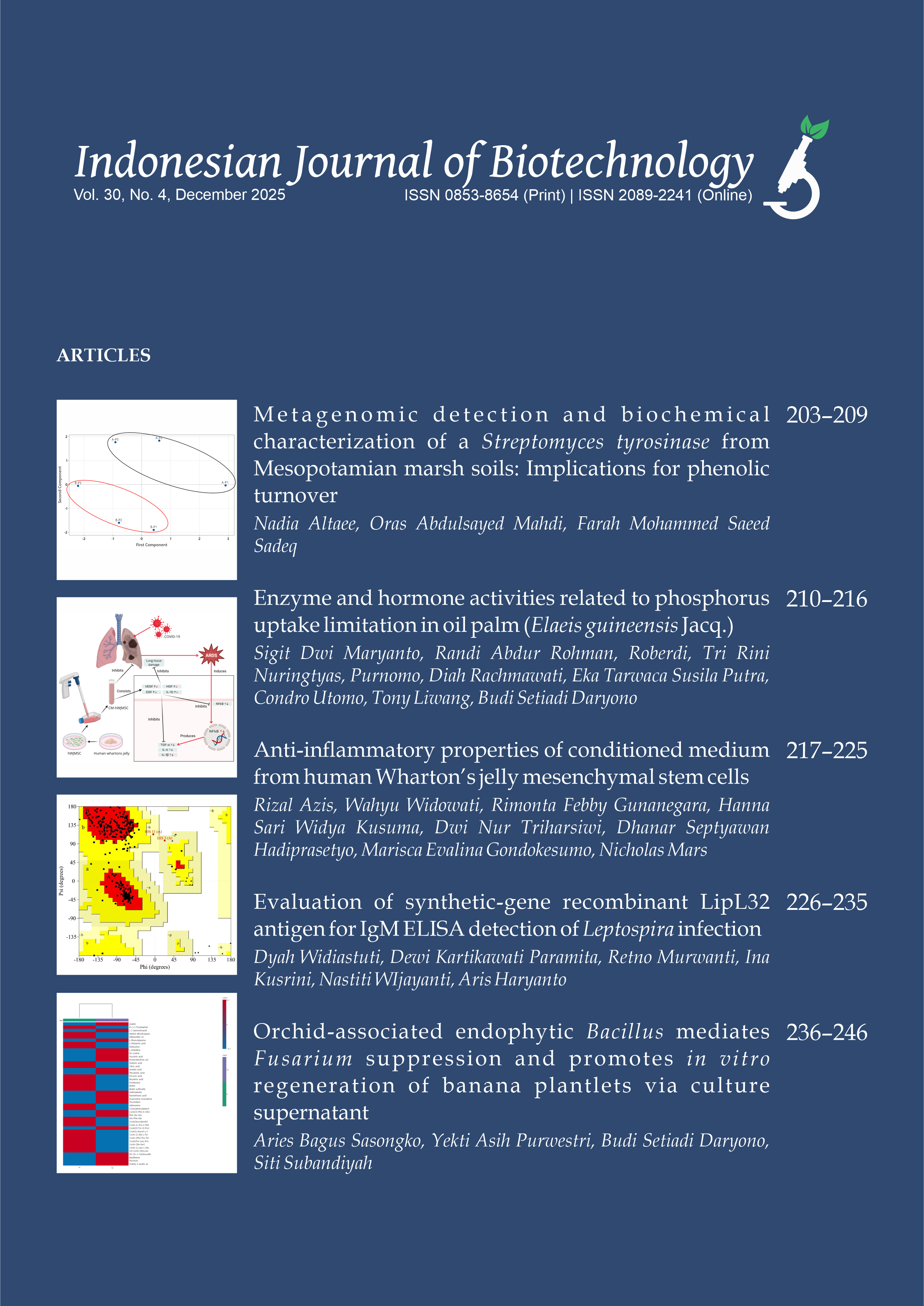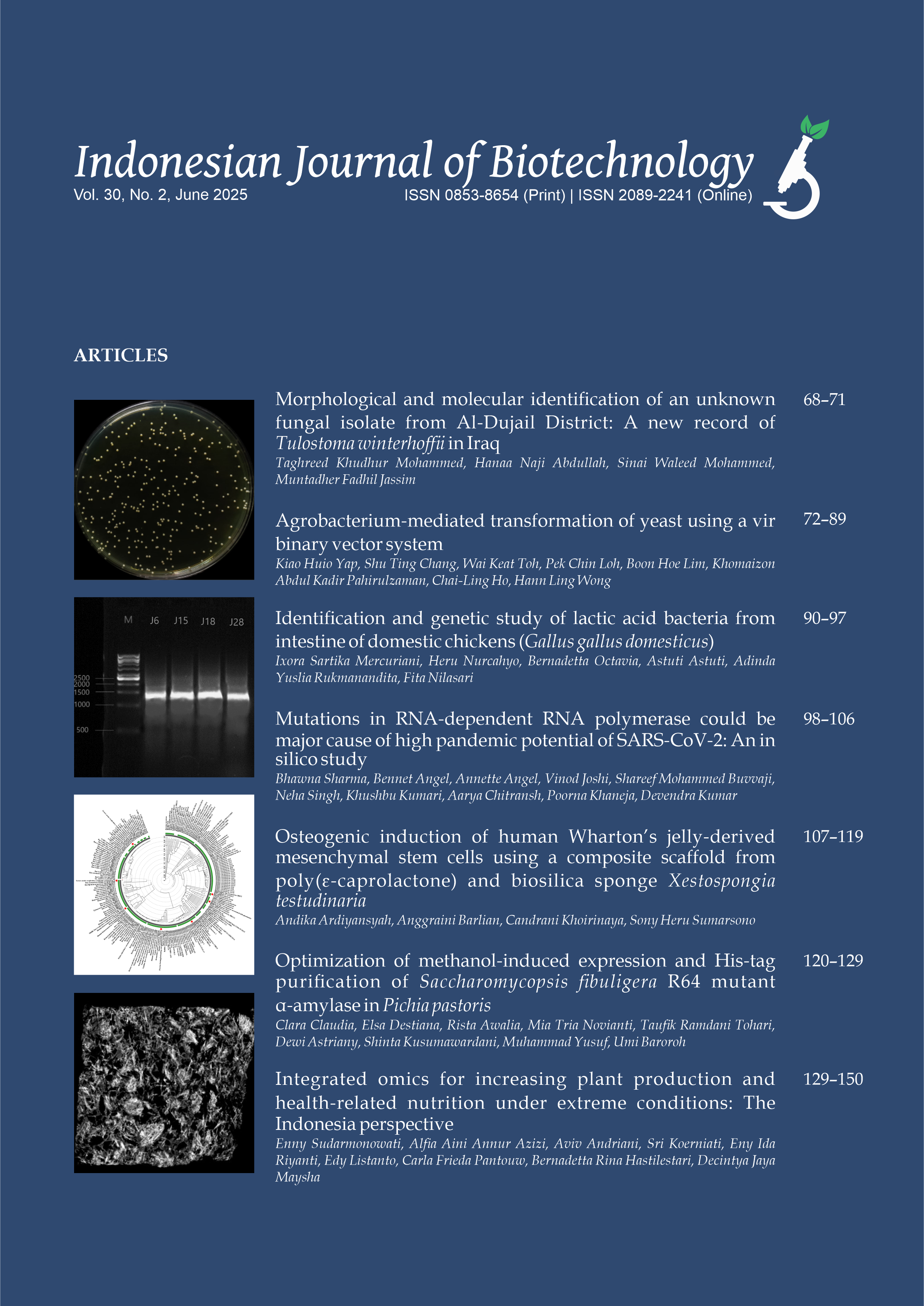Bioactivity and genetic screening of marine actinobacteria associated with red algae Gelidiella acerosa
Maria Ulfah(1), Noer Kasanah(2*), Niken Satiti Nur Handayani(3)
(1) Faculty of Biology, Universitas Gadjah Mada, Jl. Teknika Selatan, Sekip Utara, Sinduadi, Mlati, Sleman, Daerah Istimewa Yogyakarta 55281, Indonesia
(2) Department of Fisheries, Faculty of Agriculture, Universitas Gadjah Mada, Bulaksumur, Caturtunggal, Depok, Sleman, Daerah Istimewa Yogyakarta 55281 Indonesia
(3) Faculty of Biology, Universitas Gadjah Mada, Jl. Teknika Selatan, Sekip Utara, Sinduadi, Mlati, Sleman, Daerah Istimewa Yogyakarta 55281, Indonesia
(*) Corresponding Author
Abstract
Bacterial resistance to existing antibiotics has driven a search for new antibiotics from marine actinobacteria. Bioactivity and genetic screening of actinobacteria associated with red algae Gelidiella acerosa were conducted to discover new antibacterial compounds against Vibrio alginolyticus. A total of 14 actinobacteria isolates were obtained from G. acerosa. The isolates were subjected to genetic screening for nrps (non-ribosomal peptide synthetase) and FADH2-dependent halogenase genes. The isolates’ ability to produce secondary metabolites was examined by fermentation in various media in a six-well mini plate. The bioactivity of the secondary metabolites was screened using a microtiter assay and the agar overlay method. The results showed that all 14 isolates had the nrps gene, whereas none had the halogenase gene. Meanwhile, eight of the actinobacteria isolates showed antibacterial activity against V. alginolyticus.
Keywords
Full Text:
PDFReferences
Austin B. 2010. Vibrios as causal agents of zoonoses. Veterinary Microbiology 140:310–317. doi:10.1016/j.vetmic.2009.03.015.
Ayuso-Sacido A, Genilloud O. 2005. New PCR Primers for the Screening of NRPS and PKS-I Systems in Actinomycetes: Detection and Distribution of These Biosynthetic Gene Sequences in Major Taxonomic Groups. Microb Ecol 49:10–24. doi:10.1007/s00248-004-0249-6.
Bennur T, Kumar AR, Zinjarde S, Javdekar V. 2014. <Emphasis Type=“Italic”>Nocardiopsis</Emphasis> species as potential sources of diverse and novel extracellular enzymes. Appl Microbiol Biotechnol 98:9173–9185. doi:10.1007/s00253-014-6111-y.
Bennur T, Ravi Kumar A, Zinjarde S s., Javdekar V. 2016. Nocardiopsis species: a potential source of bioactive compounds. J Appl Microbiol 120:1–16. doi:10.1111/jam.12950.
Blunt JW, Copp BR, Keyzers RA, Munro MHG, Prinsep MR. 2014. Marine natural products. Natural Product Reports 31:160. doi:10.1039/c3np70117d.
Bode HB, Bethe B, Höfs R, Zeeck A. 2002. Big effects from small changes: possible ways to explore nature’s chemical diversity. Chembiochem 3:619–627. doi:10.1002/1439-7633(20020703)3:7<619::AID-CBIC619>3.0.CO;2-9.
Bull AT, Ward AC, Goodfellow M. 2000. Search and Discovery Strategies for Biotechnology: the Paradigm Shift. Microbiol Mol Biol Rev 64:573–606.
Egan S, Thomas T, Kjelleberg S. 2008. Unlocking the diversity and biotechnological potential of marine surface associated microbial communities. Curr. Opin. Microbiol. 11:219–225. doi:10.1016/j.mib.2008.04.001.
El-Shatoury SA, El-Shenawy NS, El-Salam IMA. 2009. Antimicrobial, antitumor and in vivo cytotoxicity of actinomycetes inhabiting marine shellfish. World J Microbiol Biotechnol 25:1547–1555. doi:10.1007/s11274-009-0040-4.
Elsie BH, Dhanarajan MS, Sudha PN. 2011. Invitro Screening Of Secondary Metabolites And Antimicrobial Activities Of Ethanol And Acetone Extracts From Red Seaweed GelidiumAcerosa. JournalOfChemistry Research. India: Department Of Bio-Chemistry, Jaya College of Arts and Science, Thirunindravur, TamilNadu 2:1–3.
Engelhardt K, Degnes KF, Zotchev SB. 2010. Isolation and Characterization of the Gene Cluster for Biosynthesis of the Thiopeptide Antibiotic TP-1161. Applied and Environmental Microbiology 76:7093–7101. doi:10.1128/AEM.01442-10.
Felnagle EA, Jackson EE, Chan YA, Podevels AM, Berti AD, McMahon MD, Thomas MG. 2008. Nonribosomal Peptide Synthetases Involved in the Production of Medically Relevant Natural Products. Molecular Pharmaceutics 5:191–211. doi:10.1021/mp700137g.
Gibbons S. 2006. An Introduction to Planar Chromatography. In: Sarker SD, Latif Z, Gray AI, editors. Methods in Biotechnology-Natural Products Isolation. Totowa, NJ: Humana Press. p. 77–116.
Gómez-León J, Villamil L, Lemos ML, Novoa B, Figueras A. 2005. Isolation of Vibrio alginolyticus and Vibrio splendidus from aquacultured carpet shell clam (Ruditapes decussatus) larvae associated with mass mortalities. Appl. Environ. Microbiol. 71:98–104. doi:10.1128/AEM.71.1.98-104.2005.
He S-T, Zhi X-Y, Jiang H, Yang L-L, Wu J-Y, Zhang Y-G, Hozzein WN, Li W-J. 2015. Biogeography of Nocardiopsis strains from hypersaline environments of Yunnan and Xinjiang Provinces, western China. Scientific Reports 5:13323. doi:10.1038/srep13323.
Heuer H, Krsek M, Baker P, Smalla K, Wellington EM. 1997. Analysis of actinomycete communities by specific amplification of genes encoding 16S rRNA and gel-electrophoretic separation in denaturing gradients. Applied and Environmental Microbiology 63:3233.
Holt JG. 1994. Bergey’s Manual of Determinative Bacteriology. Lippincott Williams & Wilkins.
Hornung A, Bertazzo M, Dziarnowski A, Schneider K, Welzel K, Wohlert S-E, Holzenkämpfer M, Nicholson GJ, Bechthold A, Süssmuth RD, et al. 2007. A Genomic Screening Approach to the Structure-Guided Identification of Drug Candidates from Natural Sources. ChemBioChem 8:757–766. doi:10.1002/cbic.200600375.
Hur GH, Vickery CR, Burkart MD. 2012. Explorations of catalytic domains in non-ribosomal peptide synthetase enzymology. Nat Prod Rep 29:1074–1098. doi:10.1039/c2np20025b.
Kanagasabhapathy M, Sasaki H, Haldar S, Yamasaki S, Nagata S. 2006. Antibacterial activities of marine epibiotic bacteria isolated from brown algae of Japan. Annals of microbiology 56:167–173.
Karray F, Darbon E, Oestreicher N, Dominguez H, Tuphile K, Gagnat J, Blondelet-Rouault M-H, Gerbaud C, Pernodet J-L. 2007. Organization of the biosynthetic gene cluster for the macrolide antibiotic spiramycin in Streptomyces ambofaciens. Microbiology 153:4111–4122. doi:10.1099/mic.0.2007/009746-0.
Kasanah N, Hamann MT. 2004. Development of antibiotics and the future of marine microorganisms to stem the tide of antibiotic resistance. Curr Opin Investig Drugs 5:827–837.
Lam KS. 2006. Discovery of novel metabolites from marine actinomycetes. Current Opinion in Microbiology 9:245–251. doi:10.1016/j.mib.2006.03.004.
Lee DW, Lee SD. 2008. Tessaracoccus flavescens sp. nov., isolated from marine sediment. Int. J. Syst. Evol. Microbiol. 58:785–789. doi:10.1099/ijs.0.64868-0.
Lee SD. 2006. Phycicoccus jejuensis gen. nov., sp. nov., an actinomycete isolated from seaweed. INTERNATIONAL JOURNAL OF SYSTEMATIC AND EVOLUTIONARY MICROBIOLOGY 56:2369–2373. doi:10.1099/ijs.0.64271-0.
Leonard B, Coronel J, Siedner M, Grandjean L, Caviedes L, Navarro P, Gilman RH, Moore DAJ. 2008. Inter- and Intra-Assay Reproducibility of Microplate Alamar Blue Assay Results for Isoniazid, Rifampicin, Ethambutol, Streptomycin, Ciprofloxacin, and Capreomycin Drug Susceptibility Testing of Mycobacterium tuberculosis. Journal of Clinical Microbiology 46:3526–3529. doi:10.1128/JCM.02083-07.
Li H-W, Zhi X-Y, Yao J-C, Zhou Y, Tang S-K, Klenk H-P, Zhao J, Li W-J. 2013. Comparative Genomic Analysis of the Genus Nocardiopsis Provides New Insights into Its Genetic Mechanisms of Environmental Adaptability. PLOS ONE 8:e61528. doi:10.1371/journal.pone.0061528.
Luyt C-E, Bréchot N, Trouillet J-L, Chastre J. 2014. Antibiotic stewardship in the intensive care unit. Crit Care 18:480. doi:10.1186/s13054-014-0480-6.
Martin M, Portetelle D, Michel G, Vandenbol M. 2014. Microorganisms living on macroalgae: diversity, interactions, and biotechnological applications. Applied Microbiology and Biotechnology 98:2917–2935. doi:10.1007/s00253-014-5557-2.
Matsuo Y, Kanoh K, Jang J-H, Adachi K, Matsuda S, Miki O, Kato T, Shizuri Y. 2011. Streptobactin, a Tricatechol-Type Siderophore from Marine-Derived Streptomyces sp. YM5-799. Journal of Natural Products 74:2371–2376. doi:10.1021/np200290j.
McNicholl BP, McGrath JW, Quinn JP. 2007. Development and application of a resazurin-based biomass activity test for activated sludge plant management. Water Research 41:127–133. doi:10.1016/j.watres.2006.10.002.
Mustapha S, Mustapha EM, Nozha C. 2013. Vibrio alginolyticus: an emerging pathogen of foodborne diseases. Int. J. Sci. Technol 2:302–309.
Naikpatil SV, Rathod JL. 2011. Selective isolation and antimicrobial activity of rare actinomycetes from mangrove sediment of Karwar. Journal of Ecobiotechnology 3. [accessed 2017 Dec 14]. https://scienceflora.org/journals/index.php/jebt/article/view/192.
Pace JL, Yang G. 2006. Glycopeptides: Update on an old successful antibiotic class. Biochemical Pharmacology 71:968–980. doi:10.1016/j.bcp.2005.12.005.
Pée K-H van, Zehner S. 2003. Enzymology and Molecular Genetics of Biological Halogenation. In: Natural Production of Organohalogen Compounds. Springer, Berlin, Heidelberg. (The Handbook of Environmental Chemistry). p. 171–199. [accessed 2017 Dec 14]. https://link.springer.com/chapter/10.1007/b10457.
Penesyan A, Kjelleberg S, Egan S. 2010. Development of Novel Drugs from Marine Surface Associated Microorganisms. Mar Drugs 8:438–459. doi:10.3390/md8030438.
Piel J, Hui D, Wen G, Butzke D, Platzer M, Fusetani N, Matsunaga S. 2004. Antitumor polyketide biosynthesis by an uncultivated bacterial symbiont of the marine sponge Theonella swinhoei. Proc Natl Acad Sci U S A 101:16222–16227. doi:10.1073/pnas.0405976101.
Schwartsmann G, Brondani da Rocha A, Berlinck RG, Jimeno J. 2001. Marine organisms as a source of new anticancer agents. Lancet Oncol. 2:221–225.
Schwarzer D, Marahiel MA. 2001. Multimodular biocatalysts for natural product assembly. Naturwissenschaften 88:93–101. doi:10.1007/s001140100211.
Shaw KS, Goldstein RER, He X, Jacobs JM, Crump BC, Sapkota AR. 2014. Antimicrobial Susceptibility of Vibrio vulnificus and Vibrio parahaemolyticus Recovered from Recreational and Commercial Areas of Chesapeake Bay and Maryland Coastal Bays. PLOS ONE 9:e89616. doi:10.1371/journal.pone.0089616.
Singh RP, Reddy CRK. 2014. Seaweed-microbial interactions: key functions of seaweed-associated bacteria. FEMS Microbiol. Ecol. 88:213–230. doi:10.1111/1574-6941.12297.
Soria-Mercado IE, Villarreal-Gómez LJ, Rivas GG, Sánchez NEA. 2012. Bioactive Compounds from Bacteria Associated to Marine Algae. In: Sammour R, editor. Biotechnology - Molecular Studies and Novel Applications for Improved Quality of Human Life. InTech. [accessed 2017 Dec 14]. http://www.intechopen.com/books/biotechnology-molecular-studies-and-novel-applications-for-improved-quality-of-human-life/bioactive-compounds-from-bacteria-associated-to-marine-algae.
Stach JEM, Maldonado LA, Ward AC, Goodfellow M, Bull AT. 2003. New primers for the class Actinobacteria: application to marine and terrestrial environments. Environ. Microbiol. 5:828–841.
Wyche TP, Hou Y, Vazquez-Rivera E, Braun D, Bugni TS. 2012. Peptidolipins B–F, Antibacterial Lipopeptides from an Ascidian-Derived Nocardia sp. Journal of Natural Products 75:735–740. doi:10.1021/np300016r.
Zarzycki PK. 2015. Chapter 8 - Staining and Derivatization Techniques for Visualization in Planar Chromatography. In: Poole CF, editor. Instrumental Thin-Layer Chromatography. Boston: Elsevier. p. 191–237.
Article Metrics
Refbacks
- There are currently no refbacks.
Copyright (c) 2017 The Author(s)

This work is licensed under a Creative Commons Attribution-ShareAlike 4.0 International License.









